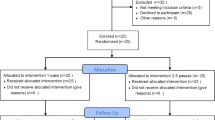Abstract
Skin hyperpigmentation is a frequently encountered problem, particularly in darker skin types. Unfortunately, standard treatments for this condition have shown disappointing results. High-intensity focused ultrasound (HIFU) is commonly indicated for skin laxity, but recently was used to treat UV-induced hyperpigmentation in animal models. This study is aimed to evaluate the efficacy and safety of high-intensity focused ultrasound for UVB-induced hyperpigmentation in human subjects. A randomized, evaluator-blinded pilot study was conducted on 20 subjects. Each subject was induced three hyperpigmentary spots by local broadband UVB. After 2 weeks, each spot was randomly allocated to control, low-energy, and high-energy HIFU. Subjects were instructed to follow up weekly for a duration of 1 month. Lightness index measurements, mean improvement scores, subjects’ satisfaction, pain scores, and side effects were evaluated. All 20 subjects completed the study. Fourteen subjects had Fitzpatrick (FPT) skin type III and six subjects had FPT skin type IV. Twelve subjects showed greater improvement at control sites while eight subjects showed greater improvement at HIFU-treated sites. In FPT skin type III, HIFU appeared to be inferior to control in both lightness index and mean improvement scores, but in FPT skin type IV, HIFU had greater lightness index improvement and higher improvement scores than control. Side effects were more frequent in high-energy-treated areas. Focused ultrasound may be offered in some patients with hyperpigmentary conditions. More research is needed to determine proper energy settings for optimal outcome.





Similar content being viewed by others
References
Callender VD, St Surin-Lord S, Davis EC, Maclin M (2011) Postinflammatory hyperpigmentation: etiologic and therapeutic considerations. Am J Clin Dermatol 12:87–99. https://doi.org/10.2165/11536930-000000000-00000
Ho SG, Chan HH (2009) The Asian dermatologic patient: review of common pigmentary disorders and cutaneous diseases. Am J Clin Dermatol 10:153–168. https://doi.org/10.2165/00128071-200910030-00002
Grimes PE (2009) Management of hyperpigmentation in darker racial ethnic groups. Semin Cutan Med Surg 28:77–85. https://doi.org/10.1016/j.sder.2009.04.001
Brenner M, Hearing VJ (2008) Modifying skin pigmentation—approaches through intrinsic biochemistry and exogenous agents. Drug Discov Today Dis Mech 5:e189–e199. https://doi.org/10.1016/j.ddmec.2008.02.001
Shah S, Alster TS (2010) Laser treatment of dark skin: an updated review. Am J Clin Dermatol 11:389–397. https://doi.org/10.2165/11538940-000000000-00000
Levin MK, Ng E, Bae YS, Brauer JA, Geronemus RG (2016) Treatment of pigmentary disorders in patients with skin of color with a novel 755 nm picosecond, Q-switched ruby, and Q-switched Nd:YAG nanosecond lasers: a retrospective photographic review. Lasers Surg Med 48:181–187. https://doi.org/10.1002/lsm.22454
Minkis K, Alam M (2014) Ultrasound skin tightening. Dermatol Clin 32:71–77. https://doi.org/10.1016/j.det.2013.09.001
Gutowski KA (2016) Microfocused ultrasound for skin tightening. Clin Plast Surg 43:577–582. https://doi.org/10.1016/j.cps.2016.03.012
Fabi SG (2014) Microfocused ultrasound with visualization for skin tightening and lifting: my experience and a review of the literature. Dermatol Surg 40(Suppl 12):S164–S167. https://doi.org/10.1097/dss.0000000000000233
Choi SY, Yoo KH, Oh CT, Kwon TR, Choi EJ, Seok J, Kim BJ (2016) High intensity focused ultrasound as a potential new modality for the treatment of pigmentary skin disorder. Skin Res Technol 22:131–136. https://doi.org/10.1111/srt.12239
Harris MO, Sundaram HA (2015) Safety of microfocused ultrasound with visualization in patients with Fitzpatrick skin phototypes III to VI. JAMA Facial Plast Surg 17:355–357. https://doi.org/10.1001/jamafacial.2015.0990
Wesley NO, Maibach HI (2003) Racial (ethnic) differences in skin properties: the objective data. Am J Clin Dermatol 4:843–860
Taylor SC (2002) Skin of color: biology, structure, function, and implications for dermatologic disease. J Am Acad Dermatol 46(2 Suppl Understanding):S41–S62
Tadokoro T, Yamaguchi Y, Batzer J, Coelho SG, Zmudzka BZ, Miller SA, Wolber R, Beer JZ, Hearing VJ (2005) Mechanisms of skin tanning in different racial/ethnic groups in response to ultraviolet radiation. J Invest Dermatol 124:1326–1332. https://doi.org/10.1111/j.0022-202X.2005.23760.x
Miyamura Y, Coelho SG, Wolber R, Miller SA, Wakamatsu K, Zmudzka BZ, Ito S, Smuda C, Passeron T, Choi W, Batzer J, Yamaguchi Y, Beer JZ, Hearing VJ (2007) Regulation of human skin pigmentation and responses to ultraviolet radiation. Pigment Cell Res 20:2–13. https://doi.org/10.1111/j.1600-0749.2006.00358.x
Pak CS, Lee YK, Jeong JH, Kim JH, Seo JD, Heo CY (2014) Safety and efficacy of ulthera in the rejuvenation of aging lower eyelids: a pivotal clinical trial. Aesthetic Plast Surg 38:861–868. https://doi.org/10.1007/s00266-014-0383-6
Berardesca E, Maibach H (1989) Cutaneous reactive hyperaemia: racial differences induced by corticoid application. Br J Dermatol 120:787–794
Acknowledgements
We thank Dr. Suthinee Rutnin for her help in histopathological evaluation.
Author information
Authors and Affiliations
Corresponding author
Ethics declarations
This study has been approved by Mahidol University Institutional Review board for Human Subject Research (protocol number 125910). The study protocol followed the guidelines of the 1964 Helsinki declaration. All patients signed informed consent before participating in the study.
Conflict of interest
The authors declare that they have no conflict of interest.
Rights and permissions
About this article
Cite this article
Vachiramon, V., Jurairattanaporn, N., Harnchoowong, S. et al. Non-invasive high-intensity focused ultrasound for UV-induced hyperpigmentation in Fitzpatrick skin types III and IV: a prospective, randomized, controlled, evaluator-blinded trial. Lasers Med Sci 33, 361–367 (2018). https://doi.org/10.1007/s10103-017-2393-5
Received:
Accepted:
Published:
Issue Date:
DOI: https://doi.org/10.1007/s10103-017-2393-5




